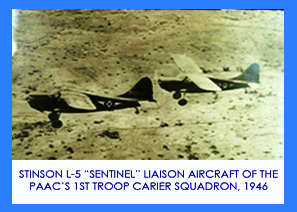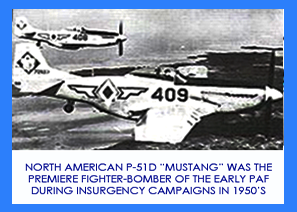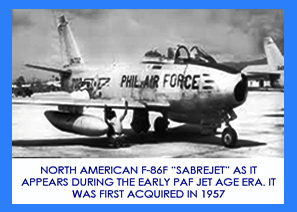 After the war, the PAAC was immediately reconstituted and pilot training was intensified. By 01 July 1947, the PAAC was renamed Philippine Air Force (PAF) and rose to a major service command of the AFP. Additional units were formed and PAF organizational structures were enhanced in response to the equipment and air assets provided by U.S. Military Aid. In the early years of the PAF, the Command was instrumentally engaged in anti-HUK and anti-Kamlon insurgency campaigns. The PAF then had established Sulu Air Task Group (SATAG), with an initial force of P-51 “Mustangs”, PBY “Catalina” amphibian planes and L-5 “Sentinel” liaison aircraft to intensify the campaign against Hadji Kamlon, who eventually surrendered in 1955.
After the war, the PAAC was immediately reconstituted and pilot training was intensified. By 01 July 1947, the PAAC was renamed Philippine Air Force (PAF) and rose to a major service command of the AFP. Additional units were formed and PAF organizational structures were enhanced in response to the equipment and air assets provided by U.S. Military Aid. In the early years of the PAF, the Command was instrumentally engaged in anti-HUK and anti-Kamlon insurgency campaigns. The PAF then had established Sulu Air Task Group (SATAG), with an initial force of P-51 “Mustangs”, PBY “Catalina” amphibian planes and L-5 “Sentinel” liaison aircraft to intensify the campaign against Hadji Kamlon, who eventually surrendered in 1955.
In November 1953, 1Lt Jose Gonzales and other pilots from the 6th Tactical  Fighter Squadron (6th TFS) of the 5th Fighter Wing (5th FW) at Basa Air Base formed a four-man PAF Aerial Precision Team aptly called the Blue Diamonds, a group of pilots which excelled in precision aerobatic flying during the Philippine Aviation Week. The Blue diamonds with their P-51 Mustangs outclassed a team of Taiwanese F-84 Thunderjets in an Acrobatic Demonstration. The Blue Diamonds then only used the P-51’s.
Fighter Squadron (6th TFS) of the 5th Fighter Wing (5th FW) at Basa Air Base formed a four-man PAF Aerial Precision Team aptly called the Blue Diamonds, a group of pilots which excelled in precision aerobatic flying during the Philippine Aviation Week. The Blue diamonds with their P-51 Mustangs outclassed a team of Taiwanese F-84 Thunderjets in an Acrobatic Demonstration. The Blue Diamonds then only used the P-51’s.
In 1955, the PAF catapulted into the jet age that elevated the Country to a level of a super power in the South-East Asia region. A number of jet aircraft was introduced to the PAF inventory when Col Godofredo Jullano, Majors Pestaña and Rancudo, and Capt Jose Gil flew an initial batch of T-33A “T-Bird” jet trainer aircraft from Japan. These aircraft first landed in Clark Air Base as Basa Air Base airstrip was not yet capable to handle jet aircraft landings. The T-33A jets were subsequently used by the 5th Fighter Wing until they were phased out in 1996.
 In 1956, the PAF acquired several squadrons of F-86F Sabres, which became ready for combat after numerous proficiency flights and were subsequently used by the 6th TFS and Blue Diamonds aerobatics team. The PAF’s Blue Diamonds performed with F-86F aircraft in 1957 and had developed to as many as 16-plane formation from the period of 1958-1962.
In 1956, the PAF acquired several squadrons of F-86F Sabres, which became ready for combat after numerous proficiency flights and were subsequently used by the 6th TFS and Blue Diamonds aerobatics team. The PAF’s Blue Diamonds performed with F-86F aircraft in 1957 and had developed to as many as 16-plane formation from the period of 1958-1962.
The middle years that followed found the PAF engaged in multifarious missions and one is establishing military relations with other allied Countries. In 1962, United Nations Secretary-General Dag Hammarskjold asked the Philippine government to send a tactical air squadron to neutralize secessionists in the Congo. In 1963, the PAF sent “Limbas” Squadron (later became 9th TFS) led by Lt Col Jose Rancudo, to join the UN Peacekeeping forces to the troubled Congo. Filipino, Swedish, Iranian fighter units and an Ethiopian air transport contingent secured the airspace over the Congo and neutralized the rebel activity which marked the end of the fatal civil war. This merited the “Limbas” Squadron the United Nations Service Medal for putting their lives on the line in service of the people. These was followed by other PAF participated foreign missions like the Battalion Combat Teams to Korea (PEFTOK), PHILCAG to Vietnam and Indonesia.
 The PAF has made distinct contributions in socio-economic development, AFP internal security operations against communist rebels and moro insurgents. In a controversial move in September 21, 1972, former President Ferdinand Marcos declared Martial Law as communist insurgency led by the New People’s Army (NPA) and the secessionists rebellion led by the Moro National Liberation Front (MNLF) gained momentum. The PAF responded to every move of the enemies. A prominent campaign of the PAF is when it staged massive air assault to free a marine battalion trapped in Sibalu Hill, Sulu. Demonstrating the crucial role of air power in suppressing the twin insurgencies, these dramatic battles proved that the Air Force was the only sustainable advantage that the military had.
The PAF has made distinct contributions in socio-economic development, AFP internal security operations against communist rebels and moro insurgents. In a controversial move in September 21, 1972, former President Ferdinand Marcos declared Martial Law as communist insurgency led by the New People’s Army (NPA) and the secessionists rebellion led by the Moro National Liberation Front (MNLF) gained momentum. The PAF responded to every move of the enemies. A prominent campaign of the PAF is when it staged massive air assault to free a marine battalion trapped in Sibalu Hill, Sulu. Demonstrating the crucial role of air power in suppressing the twin insurgencies, these dramatic battles proved that the Air Force was the only sustainable advantage that the military had.
